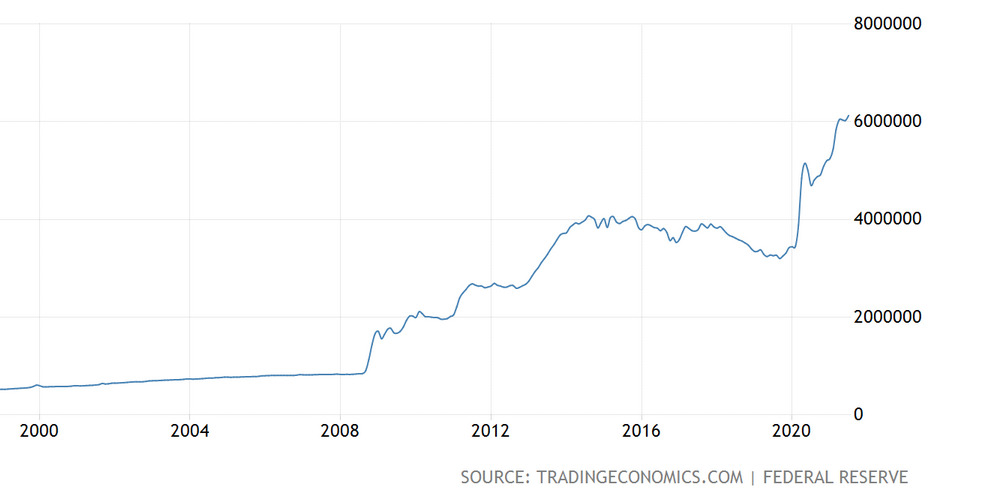Since the past 25 years Central Banks of wealthy Western countries, such as the USA, the UK, and the EU have actively been introducing new money into the economy, to fight recessions and boost inflation. Most of this new money has gone straight into the pockets of the already rich and wealthy, and the program has led to an increased wealth division in these countries. Central banks call this policy Quantitative Easing. Why are they actively doing this?
Quantitative Easing (QE) is a policy to increase money circulation and to make access to money cheaper. Central banks hope it will lead to higher inflation numbers. The effects on inflation are uncertain, but the policy does lead to increased wealth divisions. Institutions, banks, hedge funds, large corporations and wealthy families profit far more from this practice than the average Joe.
In fact, the Bank of England itself revealed in 2012 that the largest sum of the money they introduced into the economy ended up in the hands of the wealthiest, representing only 5% of the country’s population. According to an analyst: “QE cash ends up overwhelmingly in profits, thereby exacerbating already extreme income inequality and the consequent social tensions that arise from it.”
What is Quantitative Easing
In simple terms, Quantitative Easing means actively increasing the total money supply. The Central Bank creates new money and spends it on buying government bonds (loans) and corporate bonds from the market. Since those bonds are sold-out, investors now have to spend money on something else, on more risky assets. The Central Bank hopes that this leads to more investments, economic growth, higher employment, more money circulation and, ultimately, their main goal: higher inflation.
A central bank (or reserve bank) is an independent governmental agency that exist with these goals in mind: managing the country’s currency and monetary policy, as well as overseeing commercial banking. It’s not an official part of the government and is rather an independent organization. Its mandate originates from law.
Contents
Quantitative Easing Benefiting the Rich
While the central banks increase the overall money supply and utilize low-interest rates (or even negative rates), this process is creating ‘bubbles’ into the economy. Commodities and assets get overvalued because of increased demand. This increased demand is generated by the influx of the new money. The more assets that you hold, the more you profit. Therefore, during this process of QE, the Central Bank creates more wealth for the pockets of those who already have a lot.
Central Banks know of this fact, but call it a necessary trade-off. It hopes that enough money would trickle down so the economy improves and inflation increases (so that basic stuff get pricier for ordinary Joe). For example, in its 2016 annual report, the European Central Bank clearly acknowledged that its Quantitative Easing program has increased the richest citizens’ wealth. Or take this quote:
Euro Area households that hold financial assets, such as stocks and bonds, are strongly concentrated at the top end of the net wealth distribution. As such, only a fairly small subset of the population benefits from capital gains in equity and bond markets; three-quarters of the population do not benefit at all.
Quantitative Easing: More Money
Yet until today the Central Banks keep on pouring money to the wealthy. The total amount of money supply that exist in the past 25 years can be seen in the following graph, where you can observe the increase in the total money supply in the USA. The new money comes straight from the Central Bank, the money’s bookkeeper, which has the sole capacity to create and spend this newly created money.

Tools of the Central Bank
Quantitative Easing is not the only tool in the hands of Central Banks. The Central Bank’s interest rate is even a more well-known tool that Central banks use to control inflation rate. However, when a Central Bank’s interest rate is zero or even below zero (which was the case in many countries for many years until 2022), Central Banks seek other options to push spending, and henceforth inflation. Quantitative Easing is what’s used right now the most.
Quantitative Easing: Who Benefits and why?
Money created through QE (Quantitative Easing) by the Central Banks is directly put into action to buy government and corporate bonds in the financial markets. This not only leads to more bubbles due to the ever-increasing asset pricing, but this also leads to cheap money for big corporations and banks.
It is hoped that those same corporations will invest more in production and hence employment now. But investments are only really being done when there is actual increased demand (by more B2B, government procurement or consumerism). The increased demand is not created by these policies. Instead of investing, most money simply ends up in the bubbles because that’s where money yields the best.
QE only push loan rates down for governments and large corporations. Ordinary people and SME’s are mostly left with the option of borrowing money with high-interest rates and poor loan terms. SME’s (Small and Medium Enterprises), often seen as a larger driver of employment, are not profiting at the same level at all.
At the same time, your savings also decrease in value. QE is only implemented when Central Bank interest rates are already down to zero, and doesn’t lead to the solutions they are aiming for. It takes longer until saving rates will go up and in many countries pension schemes that are based on saving and not investing are placed under increased pressure.
In other words, governments have printed trillions of dollars to boost their economies. While the asset-rich have reaped the benefits of QE, millennials and the poor have lost out. A very recent economic research paper on the effects of Quantitative Easing during the Great Depression concluded something similar, emphasizing that what matters most is your focus:
If one focuses on the gap between the top 10% and all other households, QE can be seen as increasing inequality. If one focuses on the improvement of welfare at the bottom, QE can be seen as reducing inequality, as it reduces the gap between the bottom 10% and the middle of the wealth distribution.
How Does Quantitative Easing Benefit the Rich?
- Central Banks widen the gap between poor and rich by ‘printing’ new money. They use this money to buy government bonds and corporate bonds. This drives up asset pricing. And the more wealthy you are, the more you profit from it.
- Quantitative Easing directly leads to bubbles in the housing market, stock markets and possibly other basic commodities that widen the gap even further between those who own and those who don’t.
- Central banks know about these effects, but try to justify it. They say it makes people and corporations feel more wealthy, so they also spend more. For them, it’s justified in their mission to have stable inflation. However, spending on goods and services hardly increases because of this; we are just creating more bubbles. According to numbers by the Central Bank of the UK, it’s only around 8% that goes into direct spending.
Quantitative Easing in Summary: More Bubbles
- Interest rates on these bonds and henceforth its yield drop even further and instead of putting their money into bonds, investors therefore put their money elsewhere, mostly stocks, commodities and other assets (including Bitcoin).
- The bubbles makes everyone who invests feel wealthier, but it doesn’t lead to increased spending, just more bubbles. For instance, Fed’s data shows that the top 5% of Americans own up to 60% of financial assets. The amount of wealth they are winning here is vastly greater than ordinary families. Let alone those who don’t have they money or the knowledge to actually invest.
- Many families therefore do not benefit from QE in that same way. Very little money created through QE benefits the real economy. The Bank of England estimated that the first £375 billion of QE led to 1.5-2% growth in GDP, equal to an estimate of max. £30bn billion of extra spending in the real economy. That’s only max. 8%.

